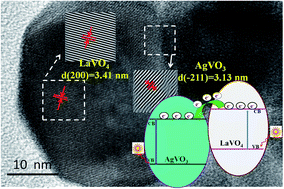The hydrothermal in situ construction of AgVO3/LaVO4 phase junctions for the efficient visible-light-driven disposal of pollutants and photoelectrocatalytic methanol oxidation†
Abstract
The design and fabrication of heterojunctions has been proven to be a facile method for improving photocatalytic performance. Herein, in this work, a high performance photocatalyst based on AgVO3/LaVO4 was successfully synthesized via a one-step in situ hydrothermal method. X-ray diffraction (XRD), scanning electron microscopy (SEM), transmission electron microscopy (TEM), X-ray photoelectron spectroscopy (XPS), Fourier transform infrared spectroscopy (FT-IR) and photoluminescence (PL) spectra were used to characterize the structural and physicochemical characteristics. AgVO3/LaVO4 composites exhibited enhanced photocatalytic activity for the disposal of simulated pollutants (66% and 36% degradation rates for methyl orange and acid orange II) and superior photoelectrocatalytic oxidation of methanol compared with noble metal (Au, Ag and Pt) supported LaVO4 and bare LaVO4 photocatalysts (a lower Tafel slope of 24 mV dec−1 and a higher peak current density of 0.22 mA cm−2 over 2% β-AgVO3/LaVO4). This could be due to the introduction of β-AgVO3 in the form of phase junctions, leading to enhanced light harvesting and the promoted separation and transfer of photogenerated electrons/holes pairs, which was proved using ultraviolet-visible diffuse reflectance spectra (UV-Vis DRS), and photoelectrochemical and time-resolved PL measurements. Density functional theory (DFT) calculations revealed that the interaction of β-AgVO3 and LaVO4 would enhance the optical absorption and electron transfer.



 Please wait while we load your content...
Please wait while we load your content...